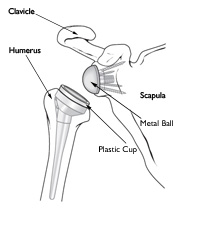
Patients who are in need of a shoulder replacement and have significant rotator cuff damage have been told in the past that they can’t have a new joint because the rotator cuff wouldn’t be able to support it.
Today, things have changed! There is a new treatment for patients who need shoulder replacement AND have rotator cuff damage. The new surgery is called a Reverse Shoulder Replacement and is performed by Dr. Paul Chin of Sterling Ridge Orthopaedics & Sports Medicine. He is one of the researchers of this surgery and was an author of an article in the Journal of Bone and Joint Surgery Reviews published in October 2014.
In traditional shoulder replacement, the parts of the shoulder that have worn out are replaced with new parts. The parts of the bones that rub together are replaced with metal and plastic parts. As you can see in this picture at the left, the “ball” is on the end of the humerus bone and the “socket” is on the scapula.
 In a reverse shoulder replacement surgery, the “ball” is attached to the shoulder blade, and the “socket” is attached to the upper arm (pictured right).
In a reverse shoulder replacement surgery, the “ball” is attached to the shoulder blade, and the “socket” is attached to the upper arm (pictured right).
This enables the deltoid muscle in the upper back to compensate for the damaged rotator cuff. Using the deltoid in this manner provides increased stability, strength, and range of motion to the shoulder joint. If you’re experiencing shoulder pain, schedule an appointment to be evaluated by one of our orthopedic surgeons. They will take images of your shoulder to see if there are options other than a shoulder joint replacement surgery that you can try first. If you and your doctor decide that shoulder replacement is the best course of treatment, they now have the ability to offer both regular shoulder replacements and the reverse shoulder replacement for those with rotator cuff damage.






